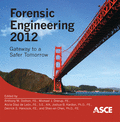Potential Problems Arising from the Use of Composite Foam Panels on Sloping Roofs
Publication: Forensic Engineering 2012: Gateway to a Safer Tomorrow
Abstract
Composite panels are increasingly common in roof applications. These panels are made by sandwiching a layer of rigid foam insulation between two facer materials. Advertised advantages include the speed of installation and the greater continuity of the insulating layer. When panels are applied to a sloping roof, the upper facing layer becomes the nailer, and the rigid foam core provides the insulation. If the insulating layer must also transfer the along-slope component of weight - roof dead load and superimposed live load - then the shearing force and compression within the foam core may lead to problems. Typically, the engineered building structure ends at the roof decking. The composite roof panels, or an assembly of insulation plus nailing layer, are specified by the architect, usually without the benefit of structural engineering. Details for attaching the composite panels usually include a fastener schedule sufficient to resist wind-induced uplift. However, the weight of the roof covering, nailing layer, and superimposed live load also includes an along-slope component which tends to induce sliding along the slope. There is not always explicit attention paid to how the upper nailing layer will be prevented from sliding. Further, where the nailing layer consists of wood panels, it is important to maintain a narrow gap between adjacent panels. Where the sliding resistance must come from shear and/or compression in the insulating layer, gaps between wood panels may close, resulting in problems for the roofing and insulation. This paper describes a case study where the rigid insulation was the only material available to prevent the wood-panel nailing layer from sliding. When they were installed, the composite panels were placed with the requisite 1/8 in. gap between the wood face panels. The gap was to be maintained by compression in the foam core along the joints between adjacent panels. Over time, however, the rigid foam core compressed, the nailing-layer panels moved down the slope, and the cumulative dimension of the closed gaps resulted in a significant separation along the ridge line. The shingle cap split, water entered, heat escaped, and the roof required significant repair.
Get full access to this article
View all available purchase options and get full access to this chapter.
Information & Authors
Information
Published In
Copyright
© 2013 American Society of Civil Engineers.
History
Published online: Jan 18, 2013
Authors
Metrics & Citations
Metrics
Citations
Download citation
If you have the appropriate software installed, you can download article citation data to the citation manager of your choice. Simply select your manager software from the list below and click Download.
